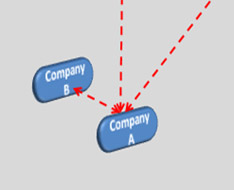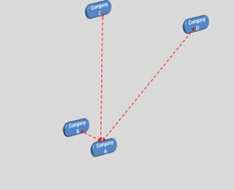By: Bengt Järrehult
Has your product lost competitive advantage? If your customers cannot differentiate your product from those of your competitors, most likely you have fallen into the “commodity trap”. The following article explores how this harmful phenomenon can be better understood and ultimately avoided by studying the dynamics within flocks of birds.
Many of us have seen a flock of birds, for example starlings, when they perform almost magical movements in the sky acting as if they were one single cloudlike individual. The same phenomena can be observed during scuba diving or snorkeling when you encounter a shoal of fish. What you really observe is what is called a self-organizing system – something quite common both in nature and society. We see it in gangs, mobs, traffic flows and even in the stock market. It is almost as if the individuals in the flock, herd, shoal, mob, queue or group have secret agreements or what Youngme Moon calls “Organic Collusions”. But do these “agreements” truly exist? Each bird seems to follow a carefully defined rule and most of these rules, these too are strongly tied to protection. Birds of prey, for instance, have difficulties to attack a herd; therefore they must focus on single individuals.
The rules behind the flock behavior was studied in the 1980’s by Craig Reynolds . He found that there are 3 extremely simple rules for each individual of the flock to obey;
- Avoid crowding or colliding with nearby birds
- Keep up with nearby birds
- Drift or shift quickly in the average direction of nearby birds
 Why am I now referring to this? Well, I see similarities when companies in a branch of business have each other under such close surveillance that they – after a while – avoid being differentiated vis-a-vis each other. Company A avoids getting too close to Companies B, C and D (Flock rule 1). It does not let these major competitors get too far away (Flock rule 2). When competition suddenly changes its behavior (offer, features or patent portfolio content or size) in a certain direction, Company A also moves in this direction – just to be safe, but often without really knowing why (Flock rule 3).
Why am I now referring to this? Well, I see similarities when companies in a branch of business have each other under such close surveillance that they – after a while – avoid being differentiated vis-a-vis each other. Company A avoids getting too close to Companies B, C and D (Flock rule 1). It does not let these major competitors get too far away (Flock rule 2). When competition suddenly changes its behavior (offer, features or patent portfolio content or size) in a certain direction, Company A also moves in this direction – just to be safe, but often without really knowing why (Flock rule 3).
 We see this behavior all around us. Look at the development of design and function of mobile phones and computers, the aerodynamic form of most cars, etc. We also see it in our own business environment. When a main competitor comes up with a certain feature, we want that feature too. What this leads to in the long run is a scary and very common phenomenon called Commoditization. We refer to it as getting into the Commodity trap where everyone has the same features.
We see this behavior all around us. Look at the development of design and function of mobile phones and computers, the aerodynamic form of most cars, etc. We also see it in our own business environment. When a main competitor comes up with a certain feature, we want that feature too. What this leads to in the long run is a scary and very common phenomenon called Commoditization. We refer to it as getting into the Commodity trap where everyone has the same features.
 What inevitably happens when you enter deeper into the commodity trap is that the surrounding world does not look upon you as a single company or brand, but only as a part of herd – although you do not see this yourself. From your perspective you see clear differences to the other starlings around you, but the observers on the ground do not. They only see a flock of starlings and not individual starlings.
What inevitably happens when you enter deeper into the commodity trap is that the surrounding world does not look upon you as a single company or brand, but only as a part of herd – although you do not see this yourself. From your perspective you see clear differences to the other starlings around you, but the observers on the ground do not. They only see a flock of starlings and not individual starlings.
When a company does competitive intelligence they must use the input carefully and always try to stake the company’s own personality and difference in terms of features or brand promise. If all participants in a specific branch of business get too close to each other, they will jointly remove their respective ability to reach out with their brands. If this happens, the customers will only look at the whole branch of business as a flock and not as individual companies or brands- They will look at you and your competitors as….Commodities… with no major differences. The only way to sell now is to lower your price…. again and again.
By Bengt Järrehult
» Download a PowerPoint Presentation for this blog!
About the author
 Bengt Järrehult is Fellow Scientist Innovation at SCA, a global hygiene products and paper company. He is also adjunct professor and visiting professor resp. at 2 departments of Lund University in Sweden. He is an avid reader of and presenter on the topics of innovation, especially on breakthrough innovation and the psychological hurdles that exist to achieve this, hurdles that we may or may not be aware of. He is of the opinion that most companies more or less know what to do to become more innovative. What they don’t know is what really hinders them from doing these measures…
Bengt Järrehult is Fellow Scientist Innovation at SCA, a global hygiene products and paper company. He is also adjunct professor and visiting professor resp. at 2 departments of Lund University in Sweden. He is an avid reader of and presenter on the topics of innovation, especially on breakthrough innovation and the psychological hurdles that exist to achieve this, hurdles that we may or may not be aware of. He is of the opinion that most companies more or less know what to do to become more innovative. What they don’t know is what really hinders them from doing these measures…
